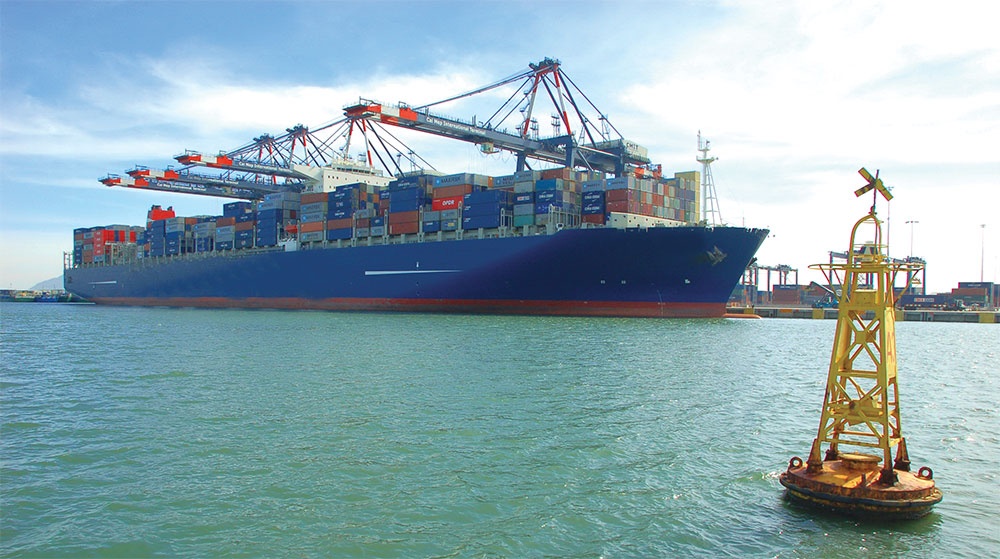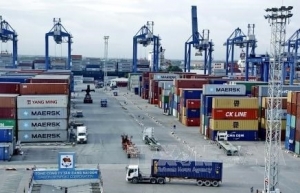Efficiency advances in logistics only accessible with digitalisation
Regarded as the blood vessels of an economy, the logistics sector took centre stage at the Vietnam Logistics Transformation Forum in Ho Chi Minh City on October 19. Phan Van Chinh, director of the Foreign Trade Agency of the Ministry of Industry and Trade, explained the value of the sector during the forum.
 |
| Efficiency advances in logistics only accessible with digitalisation, photo Le Toan |
“If logistics costs account for about 15 per cent of the value of exported goods, with an estimated total export value of $400 billion this year, it would be $60 billion, which excludes domestic activities,” Chinh said. “Regarding import activities, estimated at $300 billion, with logistics costs accounting for about 7 per cent, it is nearly $20 billion. In total, the value potential of the logistics industry can be seen at about $80 billion.”
His estimation comes from the fact that the total export value in the first nine months of the year reached $282.35 billion, and the import value reached $275.58 billion.
In terms of products, 8.2 per cent is agricultural and aquatic products, 86.18 per cent is processing industry, 1.27 per cent is fuel and minerals. There are 32 industries with export turnover of more than $1 billion, of which the six leading item groups are phones and components of all kinds ($45 billion), computers, electronic products and components ($42 billion), machinery equipment, tools, and other spare parts ($34 billion), textiles and garments ($29 billion), footwear ($18 billion), and wood and wood products ($12 billion).
Regarding shipping destinations, Asia accounts for the biggest share of 46 per cent or about $129 billion (of which China accounts for $41 billion), followed by the US ($98 billion) and Europe ($35 billion).
“Each type of product will have different shipping and delivery methods,” said Chinh, adding it is necessary to pay attention to market analysis to provide appropriate strategies. The same importance also goes to transportation routes.
He regarded the logistics industry as a co-existence partner with import and export activities. He also noted that the $80 billion estimation in logistics’ market size does not include shipping and delivery services for the e-commerce sector and other retail supporting activities, which are also constantly expanding.
Talking at the same event, although believing in the growth and transformation of logistics services in Vietnam, Chih Cheung, founding partner of SEA Logistics Partners (SLP), pointed out that there are inefficiencies and that costs are too high.
“Logistics-related costs represent about 20 per cent of GDP in Vietnam, whereas in mature markets, like Singapore or the US, it is close to 7-9 per cent,” he said.
He recalled that when GLP, a global partner of SLP, first entered China, this cost was about 20 per cent too, but these days it is only around 14 per cent.
Managing 16 ports nationwide, together with more than one million tonnes of ships and two million square metres of warehouses, Vietnam Maritime Corporation (VIMC) has played an important role in maritime shipping, port management, and other services.
In the quest for efficiency, the corporation has adopted various digital transformation measures, such as electronic delivery orders (EDO), e-billing, and e-payments. Ports have also applied terminal operating systems (TOS) for receiving containers. However, to connect EDOs with the ports’ TOS, API systems are also needed.
“This is when we wish there were an alliance of ICT and AI to support us,” said Le Quang Trung, deputy director of VIMC. He also suggested that industry insiders work together to build logistics hubs and develop shared processes based on technology.
Having her hand in the logistics sector for 18 years, Lam Bui, who is Maersk’s Sealand country manager, also approved more digital transformation and technology in logistics. She is rooting for blockchain technology as a playground for everybody. “Just imagine that all the shippers, the consignees, the buyers, and the sellers, and all the logistic providers in one platform, with security and transparency,” she said.
However, Maersk’s Sealand and VIMC only represent the big players in the sector. According to Le Thi Ngoc Diep, commercial director of SLP Vietnam, 90 per cent of registered logistics companies are small and medium enterprises that do not necessarily have either capital or human resource to follow through.
“When it comes to digital transformation, the biggest problem is the connection and integration of current logistics services systems,” she said.
In fact, matching millions of direct labourers in various logistics services across the country with a more uniform working process and compatible systems is where automation and the latest technologies can be used, but they are also a costly effort.
Besides import and export activities, the fast growth of the domestic retail and e-commerce sectors also contributes significantly to the logistics sector. Within these sectors, warehouse systems are becoming crucial. To fulfil millions of orders every day, Lazada Logistics Vietnam has invested in automation since 2017. “Surveys and studies have shown that 66 per cent of consumers have chosen one e-commerce vendor over another based on delivery options, and 54 per cent of consumers consider fast shipping to be two days or less. Meanwhile, 77 per cent of consumers said they’re more likely to do business with the same retailer again after receiving free or fast shipping,” said Vu Ngoc Thinh, general director of Lazada Logistics Vietnam.
With traditional logistics, goods are sent to fewer locations, such as distributors, and the objective is efficiency and cost savings. But in the case of e-logistics, the quantity of goods is less, and they need to be sent to many customers quickly; faster speed and being able to meet customer expectations are common goals. Therefore, a huge volume of sorting and packaging needs new solutions.
“The warehouse must have value-added services such as packing and labelling. It must be smarter, speedier, and more sustainable. Space maximisation, seasonal space expansion capability, systematic inventory management, automation, and analytics tools will ensure operational efficiency,” Thinh said.
Lazada Logistics Vietnam has employed an array of technology and AI algorithms to build several auto-sorting systems near Hanoi and Ho Chi Minh City. In a few weeks, the modern Lazada East Sorting Centre in Ho Chi Minh City is set to go live.
“Automation in warehouses is still a new concept. Meanwhile, the demand for them is high. Manufacturing enterprises tend to step up operations, and the sudden growth of e-commerce is a lever for Vietnam’s logistics market to thrive. Warehouse rent is also forecast to grow in the coming years at an average rate of about 1.5-4 per cent per year,” said SLP’s Diep.
“Robot technology used in smart warehouse model works with high accuracy, connects to cloud computing for advanced warehouse system data management, and can improve most quality indicators compared with the traditional operating model. As a result, businesses can optimise plenty of costs and resources of the business.”
 | Vietnam's logistics expenses cut by 14 per cent by 2025 Following the mid-August signing of a strategic partnership agreement, a multimodal logistics network is gradually taking form. |
 | Vietnam utilising its advantages of logistics to aid supply chain advances Vietnam’s logistics system remains less competitive than some neighbouring countries. Marco Civardi, CEO of JAS China , a privately-owned international freight forwarder, gave VIR’s Bich Ngoc his assessment of the shifting of manufacturers to Vietnam and how the country is positioning itself to be more integrated into the global supply chain. |
 | Renovation needed for logistics industry to thrive: insiders The Vietnamese logistics sector is eyeing the urgent need for renovation, overall solutions and vision as well as new development orientations to catch up with the global trend, creating a breakthrough for the country’s socio-economic recovery and development, according to experts. |
What the stars mean:
★ Poor ★ ★ Promising ★★★ Good ★★★★ Very good ★★★★★ Exceptional
Related Contents
Latest News
More News
- EVN launches major power infrastructure projects nationwide (December 19, 2025 | 18:17)
- VAL inaugurates second production line to meet domestic animal feed demand (December 19, 2025 | 16:37)
- Sun Group pioneers urban tram system in Phu Quoc (December 19, 2025 | 15:00)
- Seven major projects launched to drive Hanoi’s next growth phase (December 19, 2025 | 14:00)
- Securing capital and efficiency for Vietnam’s 2026-2030 growth ambitions (December 17, 2025 | 10:00)
- Vietnam bucking trend in the global M&A landscape (December 16, 2025 | 14:20)
- HDS Summit spotlights Vietnam’s rising role in regional supply chains (December 16, 2025 | 08:00)
- Kolon signs $48 million airbag supply deal with Autoliv (December 15, 2025 | 18:14)
- National Assembly approves Vinh–Thanh Thuy expressway project (December 15, 2025 | 18:02)
- Quang Tri green-lights $1.59 billion LNG-fired power project (December 15, 2025 | 17:59)

 Tag:
Tag:






















 Mobile Version
Mobile Version